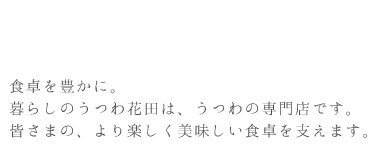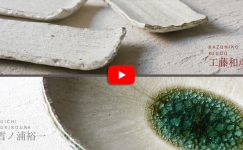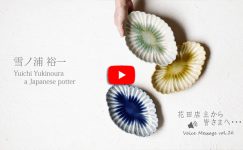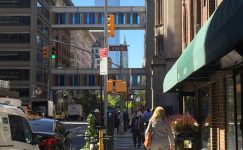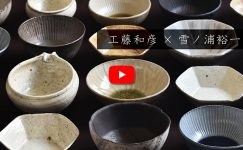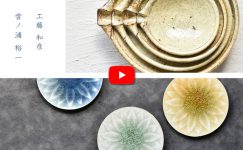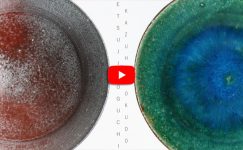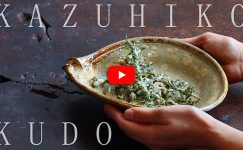English version of the interview here.

Pre‑Exhibition Interview: Kazuhiko Kudo
Hanada: Could you tell us about the path that led you to your current work?
Kazuhiko Kudo:
I was originally interested in painting and enrolled in the design department of a technical high school.
There happened to be a ceramics club there. Most of the members were actually teachers (laughs).
It had this atmosphere of a hobby circle for the faculty, and I happened to join in. The teachers looked like they were having such a great time that I decided to join the club.
Then we had the opportunity to sell our works at the school festival, and the response was unexpectedly good.
I thought, “How amazing that something I made just because I liked it could make people so happy.”
That woke something up in me, and from then on, during summer and winter breaks, I traveled alone to pottery regions around Japan—Shigaraki, Bizen… mostly hitchhiking because I had no money.
Hanada: That proactive spirit is very you.
Kazuhiko Kudo:
Nowadays it feels more common for young people, but back then high school students hardly ever visited kilns.
So everyone welcomed me, treated me to meals, even gave me pocket money. Wonderful people (laughs).
That’s when I decided to become a ceramic artist.
Hanada: And that led you to visit Shigaraki potter Ms. Kiyoko Kouyama.
Kazuhiko Kudo:
Yes, right after graduating high school. She turned me down at first, but after visiting several times, she accepted me.
I studied under her for three years.
Hanada: And you had many encounters there as well.
Kazuhiko Kudo:
Through Ms. Kouyama’s involvement in founding the bone marrow bank, I also connected with people in welfare fields.And there I saw something unforgettable:
Elderly individuals with intellectual disabilities creating objects—works that possessed something instinctive, a certain raw power, a strong sense of presence.
It was fundamentally different from what I had been making.
I think I felt the pure essence of creation there.
Because of that experience, I worked for two years as a vocational instructor at a prefectural welfare facility in Shiga.
Later, a new facility was planned in Kenbuchi, Hokkaido, and I was invited to join.
During the site visit, what I saw was a landscape of pure clay—the entire construction site was clay.
The director and I immediately agreed that we should use that clay to make pottery. It was an instant decision.
I taught pottery there for two years, and in 1996 began the ceramic work I do now.
Hanada: A series of instantaneous decisions . When I look back at my own life, impulsive and intuitive decisions often become major turning points. Now, I’ve heard that developing your Yellow‑kohiki pieces was quite a struggle.
Kazuhiko Kudo:
It took five years to complete.At the time, I was the only one using that clay.
Even in Hokkaido, local clay was mainly used for bricks and pipes, not tableware.
The clay here is difficult to handle—prone to cracking when dried, with low fire resistance.
But it’s unusual and incredibly attractive—something about it pulls you in.
When I consulted the local geological research institute, I happened to meet Mr. Yahata, a specialist in Kenbuchi clay.He told me the clay was 200 million years old.
And that the yellow dust found in it had traveled from Siberia by air currents about 45,000 years ago.
It’s a geological material not found elsewhere in Japan.
Hanada: Two hundred million years—that’s before the age of dinosaurs.
Kazuhiko Kudo:
My imagination just exploded. I was completely fired up.
Hanada: And you were determined to make it your own.
Kazuhiko Kudo:
Yes—my switch flipped completely.
Hanada: The clay is very fine‑grained, right? That sounds like it could be an advantage.
Kazuhiko Kudo:
It’s difficult to handle, but if you use its uniqueness well, it becomes a strength. If I could master it, I’d be the first in the world to do so. It would become my original material.
Because the clay is fine and sticky, it allows me to make thin yet sturdy pieces.By using those strengths while gradually solving the problems, I made progress. It’s also important to me to use local materials.
Working with local plants and clay while developing my own techniques deepens my attachment to the work.
Pottery inevitably reflects the climate of its land. If I’m in Hokkaido, I want to use its materials fully.
Hanada: You even dig the clay yourself with a shovel.
Kazuhiko Kudo:
Yes. I use only what I can take from the earth myself. If I don’t dig it myself, I feel I would lose humility—and something important might slip away.
Hanada: Your work is simple yet truly one‑of‑a‑kind.
Kazuhiko Kudo:
I try to stay conscious of how the maker’s inner world appears in the work. You must be prepared for that. I aim for strength within simplicity. Excessive self‑assertion isn’t good.
Hanada: Originality and self‑assertion are different things.
Kazuhiko Kudo:
If the maker asserts too much, I feel it becomes harder for the user to connect with the vessel. Once it leaves my hands, it belongs to the user.
I want to leave room—space where the user can bring their own feelings. I don’t want to fill everything with my own expression.
Hanada: A vessel exists in the user’s hands far longer than in the maker’s. Tableware isn’t made to be made or sold—it exists to be used. Of course, making something sturdy is a prerequisite.
Kazuhiko Kudo:
Exactly. I aim to make vessels that fascinate people when they plate food or use them.
Hanada: Your warmth and brightness come through naturally in your work. Your fans seem to have grown.
Kazuhiko Kudo:
Yes—many people aren’t just customers but supporters. I’m very grateful.
Hanada: That’s because of who you are! (laughs)
Kazuhiko Kudo:
Living in Hokkaido lately, I’ve been thinking—new culture usually enters Japan from the west.
Just as Kohiki came from the Korean Peninsula, it reaches Hokkaido last geographically. Maybe Hokkaido is the anchor of pottery culture.
There are still few ceramic artists here, and to me, working with clay in Hokkaido feels like climbing an unexplored peak.
Having lived in Shigaraki, I feel the contrast between established and non‑established production regions even more strongly.
Being in a developing pottery region means contributing to building a unique Hokkaido identity.
Though maybe that’s just me misunderstanding things, as usual (laughs).
Hanada: Even if it’s a misunderstanding, having ambition or a sense of mission matters in one’s work. Sometimes those seemingly naïve ideas are important.
Kazuhiko Kudo:
Exactly. Without a little misunderstanding, you couldn’t keep being a potter.
And I want to create from zero to one, not from one to two.
Hanada: Creating something out of nothing takes power, but it makes each day fulfilling. The process is as meaningful as the result.
Kazuhiko Kudo:
What you build yourself is something you can truly value. People might say I always make similar things, though.
Hanada: Your Kiko‑kohiki katakuchi bowl is a long‑time bestseller.
Being repetitive isn’t inherently good or bad—it depends on the content.
Now, for the February exhibition, your color variations have expanded, and your wheel‑thrown and molded works feel more refined.
Kazuhiko Kudo:
It takes me about ten years to complete one thing.
The green kohiki I’ve been working on for six years—its color has finally improved.
Hanada: I remember when you showed me your research. Green developed from slip has a different feel from the Oribe‑style green applied over the surface—cleaner and softer.
Kazuhiko Kudo:
Color is difficult. A slight change can make it better or worse.
Hanada: Yellow, white, green—the three colors enhance each other. You end up wanting all three.
Kazuhiko Kudo:
Thank you. I’m working hard toward February, so I appreciate your support.
≪ END ≫

企画展直前インタビュー 工藤和彦
花田:今の仕事に至る経緯、お話しいただけますか。
工藤:元々絵に興味があって、工業高校のデザイン科に進学しました。
たまたまそこに陶芸部があって。そこって、部員のほとんどが、教職員なんですよ(笑)
教員向けの趣味のサークル、みたいな雰囲気になっていて・・・
たまたま、そこに混じっていたら先生たちがすごく楽しそうだったので入部しました。
そして、文化祭でその制作物の販売機会があって、予想外にその反応がよかったのです。
自分が好きで作ったものがこんな風に人をハッピーにすることができるなんて最高だな、と。
急に目覚めて、それからは夏休みや冬休みっていうと全国のやきもの産地を一人で訪れていました。
信楽、備前・・・お金もないのでヒッチハイク主体です。
松井:工藤さんらしい行動力です。
工藤:最近は随分若い人たちにとって身近になってきた気がしますが、
当時は高校生なんか滅多に窯元に来ないでしょう。
だからみんな歓迎してくれるし、ごちそうしてくれたり、
お小遣いくれたり、素晴らしい人たちだなって(笑)
それで陶芸作家になると決めた。
松井:それで信楽焼作家神山清子先生を訪れるわけですね。
工藤:はい、高校卒業と同時に。最初は断られましたが、何度か訪れていたら認めてくれて。
そこから3年、色々勉強させていただきました。
松井:そこでも色々な出会いがあったそうですね。
工藤:神山先生の骨髄バンク設立の活動に関わらせ頂いて、福祉関係の人たちともつながりができてきました。
そこであるものを目にするんです。
福祉の現場で高齢の知的に障がいのある方が、オブジェを作っているんです。
それには、本能に近いもの、ある種の迫力が備わっていて、ものとしての存在感が強烈でした。
僕がそれまで作っていたものと、何かが根本的に違うんです。
もの作りのピュアな部分を感じたんですね、恐らく。
そんなこともあって滋賀県立の福祉施設で職業指導員として2年間勤めます。
その後北海道の剣淵町に新たな施設ができることになり、そこへ誘われました。
その現場視察の際、目にしたのは、建築現場全て粘土の風景。
その粘土でやきものを作っていこうと当時の施設長と意気投合。即決ですよ。
そこで2年間やきものの指導をして、平成8年に今のような陶芸活動を始めました。
松井:即決の連続ですね(笑)
自分を振り返ってみても、衝動的、感覚的な決断って
あとから考えると、人生にとって大きなポイントになっている気がします。
さて、黄粉引も結構作り出すのに苦労されたと伺いました。
工藤:完成まで5年かかりました。
当時その粘土を使っているのは僕だけでした。
北海道では地元の粘土がレンガや土管に使われても、食器にはあまり使われていませんでした。
そもそも扱いにくいんですよ、ここの土。
乾燥すると切れやすい。耐火度も低いのです。
でも、変わった土で、なんか魅力的でひきつけられるんです。
それで、現地の地質研究所に相談に行ったら、偶然にも八幡さんという剣淵粘土の専門家に出会うことができました。
そこでその土が2億年前の粘土であることを知るんです。
そして、4万5千年前くらいからシベリアから気流に乗って日本に飛来した黄砂であるんだと。
日本には無い地質なんです。
松井:2億年前というと恐竜時代以前じゃないですか。
工藤: もう、イメージが膨らみまくって、テンションあがりまくって。
松井:で、絶対、自分のものにしてやろうと。
工藤:そう、完全にスイッチ入りました。
松井:たしか、土のきめが細かいと。それは良い方向へ作用し得る気もしますが。
工藤:扱いにくいけど、特殊であることをうまく活かせばいいんです。
ものにできれば、世界で最初。自分のオリジナルが出来上がる。
土もきめが細かくて粘りがあるので、薄手でしっかりしたものが作れるんです。
そういった長所を活かしつつ、問題点を少しづつ克服していきました。
僕にとって地元の材料を使うことも大切です。
地元の植物や粘土を活用しながら自分で技術や製法を成熟させていく過程は、
仕事に対する愛着を積み上げていってくれるんです。
特にやきものは、どうしたってその土地の風土がにじみ出てくるもの。
どうせ北海道にいるならとことん使っていこうと。
松井:土もスコップで自ら掘り出します。
工藤:そうです。大地から自力でとれる分だけを使わせていただく。
自分で掘り出すことをしていないと、謙虚でいられなくなるような気がするし、
なにか大事なものが、いつの間にか失われてしまう気がするんです。
松井: 工藤さんの作るものはシンプルであり、オンリーワンですね。
工藤:気をつけているのは、ものに出てきてしまう制作者の内面です。そのあたりは覚悟しなくてはいけない。
そして、シンプルの中にある力強さ、を目指しています。自己主張が強すぎても良くないと考えています。
松井:オリジナリティと自己主張は違います。
工藤:過度な自己主張は、使う人がうつわに心を寄せにくくなってしまうんじゃないかなって。
僕の手から離れたら、もうそれは使う人のものですから。
使う人が心を寄せる余白は残しておきたい。
僕の表現で埋めてしまいたくない。
松井:通常、ものは使う人の手元に一番長く存在します。
また、少なくとも食器については、作るためにあるわけでも、売るためにあるわけでもない。
当然ですが、使うためにあるんです。
しっかりしたうつわを作ることは大前提ですが。
工藤:そうですね。料理を盛り付けたり、使っている時にハッとその良さに
気づいてもらえるようなうつわが僕の目指すところです。
松井:工藤さんのおおらかさ、明るさ、といった雰囲気が自然なかたちでうつわに吹き込まれていると思います。
フアンも随分増えたみたいですね。
工藤:みんな、お客様というより、応援してくれる人が多いんです。ありがたいです。
松井:それは工藤さんのお人柄です!(笑)
工藤:最近北海道にいて思うんです。
大体日本に新しい文化が入ってくるのって、西からですよね。
粉引が朝鮮から入ってきたように、北海道に伝わってくるのは地理的に最後。やきもの文化のアンカーなのかなって。
北海道にはまだ陶芸家は少ないし、僕にとって、北海道での焼き物の仕事は未踏峰の山なんです。
信楽にいたので、産地と非産地の違いはなおさら感じます。
陶芸新興エリアであるというのは、北海道らしさを築いていくことに加担できるという魅力もあります。
僕お得意の思い違いかもしれないけど(笑)
松井:仕事をしていく上で、たとえ思い違いでも、志や大義ってのは大切だと思います。
青臭く聞こえるようなことも時には必要です。
工藤:そうそう、思い違いが無ければ陶芸家、やっていられないですよ。
それと、僕は1から2でなく、0から1を作りたい。
松井:何も無いところから何かを作り上げるのは馬力が要りますが、その分、日々充実しますよね。
結果も大事だけど、その過程もとても有意義だと思います。
工藤:自分で築き上げたものって大切に出来るんです。僕なんて、いつも同じようなものばかり作って、って言われそうですが。
松井:黄粉引片口鉢はロングセラーです。
ワンパターンであること自体は、別にいいことと決まっているわけでも悪いことと決まっているわけでもない。
内容によります。
さて、2月の企画展に向けてですが、色のバリエーションも増えてきました。
轆轤や型ものも随分引き締まってきたように感じます。
工藤:僕はひとつのこと作り上げるのに10年くらいかかってしまうんです。
6年目になる緑粉引。やっと色が良くなってきました。
松井:色々研究している時に見せてもらいました。
化粧土から引き出す緑というのは、織部のように上からかけて発色させる緑とはまた雰囲気が変わりますね。
すっきりしていて柔らかい感じです。
工藤:色って難しいです。ちょっとした具合でよくも悪くもなる。
松井:黄、白、緑と三色並べると引き立てあいます。三色そろえたくなります。
工藤:有難うございます。今、二月に向けて頑張って作っていますので、宜しくお願いします。





